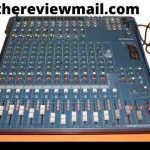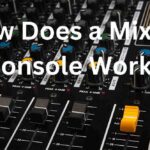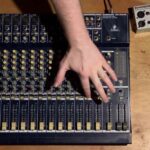Today we will discuss about the best mixing console for recording studio. The audio mix is essential for multi-track recordings in the final stereo sound. A mixing console from a group of tracks by adjusting individual tracks and combining their volume, parity, and compression.
The mixing console is an unavoidable part of live music and recording. The selection of the mixing console for recording studio is always confusing. Here I discuss the best mixing console for recording studio.
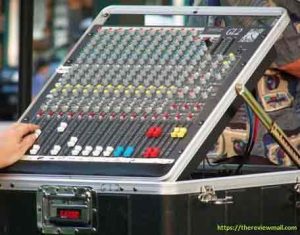
Table of Contents
What Are Mixers Used For In Studios?
Mixers are a crucial part of any recording studio. They allow you to combine and balance the levels of multiple audio sources, such as microphones, instruments, or vocals. Also, this is adjusting the volume level on each input channel and then balancing them with one another using the faders on the mixer’s control panel.
The result is a well-balance sound that records onto an analog or digital media like tape or hard drive, respectively. The audio mixer output is typically connected to a power amplifier and loudspeakers for live music events or playback through headphones for recording purposes. Read more…
What Kind Of Mixing Console Is The Best For My Professional Home Recording Studio?
The best mixing console for your professional home recording studio depends on various factors including your budget, the size of your studio, the type of music or audio you are recording, and your personal preferences. Here are some popular options across different price ranges:
Budget-Friendly Options: If you are looking for a good mixing console without breaking the bank, you might consider brands like Behringer, PreSonus, and Allen & Heath. Models like the Behringer X32 or the PreSonus StudioLive Series III offer a lot of functionality at a relatively affordable price.
Mid-Range Options: In the mid-price range, you might look at options from brands like Yamaha, Soundcraft, or Mackie. The Yamaha MG Series, Soundcraft Signature Series, and Mackie VLZ4 Series are all well-regarded.
High-End Options: For a professional home recording studio with a higher budget, you might consider high-end mixing consoles from brands like Solid State Logic (SSL), Neve, or API. The SSL AWS Series, Neve Genesys, and API The Box are all excellent choices, though they come with a significant price tag.
Digital vs. Analog: Another important consideration is whether you want a digital or an analog mixing console. Digital consoles offer more flexibility, easier recall of settings, and often include built-in effects and processing. Analog consoles, on the other hand, are prized for their warmth and character.
Size and I/O: Make sure to choose a console that fits your space and has enough inputs and outputs for your needs. Consider how many microphones, instruments, and other audio sources you plan to connect, as well as how many outputs you need for monitors, speakers, and external processing.
Integration with DAW: If you use a digital audio workstation (DAW) for recording and editing, you might want a mixing console that integrates seamlessly with your software. Some consoles offer DAW control functionality, allowing you to use the console’s faders, knobs, and buttons to control your DAW.
Brand and Reliability: Lastly, consider the brand’s reputation for quality and reliability. Read reviews, ask for recommendations from other professionals, and possibly test out a few options if possible before making your decision.
Remember, the best mixing console for you depends on your specific needs and preferences, so it’s worth taking the time to research and consider all your options before making a purchase.
List of Best Digital And Audio Mixers For Recording Studio!
- BEHRINGER,32 40 –Input 25 Bus digital Mixing desk console
- Tascam DP-24SD 24-Track Digital Portastudio Multi-Track Audio Recorder
- G-Mark professional Audio Mixer with 16 Channel
- BehringerXenyx X 1222 USB 16 input mixer
- Pyle Professional Audio Mixer Sound Board Console Desk System Interface 8 Channel DJ and studio console mixer
- Mackie ProFXv2, 8 A-B Box, 8-channel (PROFX8V2)
- Allen & Heath Zed-12fx 12-Channel Mixer
- Zoom LiveTrak L-12 Digital Mixer & Multitrack Recorder
- BehringerXenyx X1622USB Premium 16-Input
- Mackie 1604vlz4 16-Channel Compact 4-Bus Mixer
Best Mixing console for Recording Studio
Let’s know details about the 10 best mixing console for recording studio step by step.
1. BEHRINGER, X32 40 – Input 25 Bus digital Mixing console:
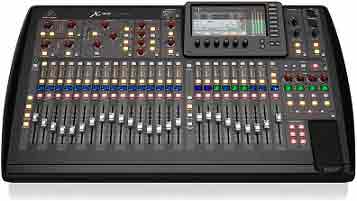
Best for Digital Mixing Console
Key Features:
- Enhanced Workflow & Multi-Channel Networking
- Motorized Faders
- LCD Scribble Strips
- 7″ Main Display
- DCA Groups
- Acoustic Integration
- 100-Band RTA for all Channel/ Bus EQ’s
BEHRINGER compact X32, 40 input channel 25-bus mixing console is best for studio production and live performance.
Three companies, MIDAS, KLARK TEKNIK, and BEHRINGER, give their best effort to build. Also, the best sounding, technically-advanced audio products, and BEHRINGER, X32 40-Input 25-Bus Digital Mixing Console is that product.
All nifty features categorize this digital mixer at an affordable price that beats the other brand in the market. The X32 compact can combine the ok analog Input or output with robust connectivity for 40 channels, 25 buses up to 152 Signals.
This 10 channel mixer has 16 Midas fully programmable mic preamps that ensure audiophile sound quality. For powerful scene management and DAW control, 17 fully atomized 100 mm motorized faders are adding.
Digital mixers are designed by 8 XLR output with six additional lines in/work, two phone connectors, a talk back section, and an external microphone. Individual and dynamic LCD scribble strips are added for easy assignment through the channel.
The USB is a 2.0 audio interface in 32X32 channels with HUI and Mackie control. X32 compact has a 7″ day viewable color Thin-film transistor display that shows the setting parameter.
The channel processing parameter is controlled by the channel strips, which contain the frequency shaving, bus transmission, priming setting, mono, primary and stereo pan.
With a networked remote control with incredible flexibility, one can easily control the parameter by 800 x 480 graphic UI. X32 compact can connect with the iPad and iPhone to control the mix anywhere.
The analog mixer has a digital controlled amplifier that controls multiple signals via a single fader. So it’s another best mixing console for the recording studio.
Pros:
- Unbelievable features amaze the consumer.
- Color display, motorized fader, preset bands sound check makes the high-quality sound.
- The capability of plug and play virtually with any device makes it flexible.
Cons:
- Some consumers wish to have a super jack in XLR, and an HDMI video output hook should be included in the feature.
2. Tascam DP-24SD 24-Track Digital Portastudio Multi-Track Audio Recorder:
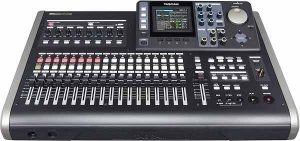
Best for Home Recording Studio
Key Features:
- 19 faders eliminate layer structuring
- 3.5″ full-color LCD and self-illuminated buttons
- 12 rotary knobs are linked to the LCD for easy operation
- Solid-state SD/SDHC media ensures confident recording
Tascam DP is an easy-to-use unit for beginners. Also, the best audio mixer for beginners has a 3.5″ screen in the top right corner. The best analog mixer for a home studio has several features like (auto record, track selecting, bouncing mastering, play, solo, mixdown, automatic punch, etc.)
However, It has a 12v DC supply. It helps you record, mix, and edit without using other gears. But you can use any gear to increase its advanced features.
Your master file is available in wave format. You can convert it to other formats like mp3 version etc., using your computer or directly from an SD card.
Sometimes using an SD card takes longer than usual to transfer those individual tracks. You can even transfer them to your computer as individual tracks.
However, the best audio console start time was not accurate for recording in the beginning. Also, virtual tracks and any other takes will include a direct transfer from SD.
The best analog mixer for live sound neither has any CD burner inside nor any drum machine. Editing is done in 7/10th increments. DP24SD is a machine that is capable of recording and editing sounds and tracks
Although there is no midi functionality, you can still synchronize your midi sequencer with this unit. However, you will also need a sequencer with an SMPTE clock generator. It’s one of the best mixing console for recording studio.
Pros
- Easy to use.
- continuously records six tracks
- affects implementation
- midi functionality
- It is a solid, reliable unit
- Well built
Cons
- Unstable construction.
3. G-Mark professional Audio Mixer with 16 Channel:
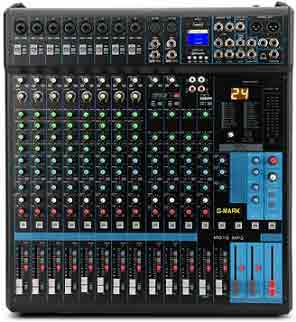
Best for Professional Use
Key Features:
- 16 input pots (8 monaural + 4 stereo)
- Two display screens
- Phantom power switch and PAD switch
- Bluetooth mixer
- EQ and high-pass filter
- Audio interface mixer are rugged
G-Mark is a famous brand for producing an excellent best audio mixers product with superior stability, outstanding live sound quality, and better consistency. They make their product by controlling audio production costs and giving advanced quality.
This Professional Audio Mixer Sound Board Console System with 16 Channel is their new invention. It has digital USB Bluetooth MP3 computer input, 48 V Phantom power, eight mono, four stereo inputs lines, and a microphone preamplifier.
The best audio mixer for live performance is a premium MG16 MP3 with a 24-bit SPX digital effect, two display screens capable of Bluetooth, and a USB input channel. Also, PAD switches can combine various higher input signals to line level to avoid chipping.
The phantom power switch and PAD switch can use the condenser microphones and give high-quality sound.
This Professional Audio Mixer has a single knob compressor that can change the emotional level of an audio signal; 3 band equalizers on every mono channel can control the sound. A high pass filter can eliminate low-frequency noise that results in smooth live sound delivery.
The best cheap digital mixer stereo output is an XLR type connector that prevents accidental disconnection to the power control knob.
This best analog mixer has built-in SPX 24 program effects that give an outstanding performance in live music or multi-track recording. So, this is one of the best recording studio consoles.
Pros:
- The mixer has a rugged construction.
- That gives good sound quality.
- Flexible design
- The inbuilt SPX 24 program can give stable performance in recording and live performance.
- Bluetooth wireless connectivity.
Cons:
- Some consumers think there is a fault in the stereo slider, so it needs to adjust later.
Also Read: Best Cardioid Condenser Mic MXL 770 Review
4. Behringer Xenyx X 1222 USB 16 input mixer:
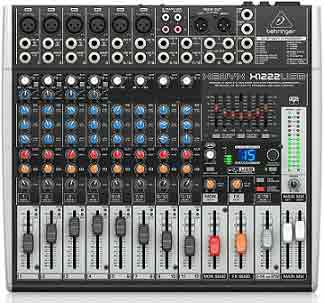
Best Analog mixer for Home Studio
Key Features:
- Equipped with channel Inserts for inputs
- Built-in Digital Multi-FX Processor
- Full-sized faders for Monitor and FX Sends
- Mandy Voice Canceller function for removing vocals from pre-recorded media for “instant-karaoke” applications.
- FBQ – Totally Feedback-Free
- Sublimely Musical British EQ
- Studio-Quality Compressor
- Sonically Superior Mic Preamps
Behringer Xenyx X1222USB is a premium 16 input 2/2 bus mixer with ultra-low noise headroom analog mixers.
This analog mixer is constructed with XENYX Mic Preamps & compressor,24 Bit Multi-FX processor, and British EQs system. British 3 band EQ can be easy to use, and a one-knob compressor ensures the clarity of the mixer.
Forgiving professional-quality recordings, Xenyx X1222USB provides state-of-the-art tools. Also, Inbuilt USB audio interfaces can give a versatile live performance. Most audio interfaces only have 1-2 inputs and outputs, depending on the brand and model.
Xenyx has excellent features with four studio-grade compressors and one knob controller that gives LED for vocal and instrumental sound. This best sounding mixing console has a new studio-grade FX processor with 16 editable multi-effects.
The presence of a built-in USB/audio interface can directly connect to the computer that ensures free audio recording, editing, and downloading software.
The feature includes a seven band stereo graphic EQ for frequency control. So, Voice cancellers can provide sing-along applications. It’s one of the best small mixer for live performance.
Pros:
- A sufficient input channel ensures great quality work in recording to the studio.
- The mixer is exceptional for sound output and good for voice recording in the studio.
- Inbuilt USB input gives a smooth and clear sound.
Cons:
- Sometimes popping and crackling observe in the USB input channel.
5. Pyle Professional Audio Mixer 8 Channel DJ and studio console mixer:
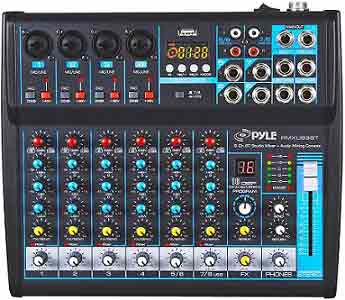
Best for Professional Use
Key Features:
- USB/Flash Reader /MP3 Compatibility
- Bluetooth Wireless Music Streaming
- Mic and Stereo Line Inputs
- Rugged Steel Chassis
- New Multi-Voltage Power Supply
- 8 Channels High Headroom Mixer
- Built-in Digital Effects
The Pyle pro PMXU83BT is a compact eight-channel DJ and studio console mixer that features an in-built Bluetooth wireless receiver, multi eight channel audio source mixing capacity.
This mixer can directly connect to the computer by FX analog effects and 16 Bit DSP processor. This is a perfect mixer for beginner at affordable prices.
Rotary adjustable knobs feature this eight-channel pro audio DJ or studio mixing console with LED indicator lights. The multichannel mixing capacity is used for DJ s, musicians, sound engineers, and live performances.
This nice music console has four XLR -1/4″ combo input and two stereo inputs pair 1/4″ RCA Jack. The Microphone offers 48 V phantoms Power that increases up to 64 dB of gain. Input channels have 3 Band EQ and indicators. So, It’s another best mixing console for recording studio.
Besides this, the mixer is built with outstanding features that attract beginners to professionals to buy this item.
Pros:
- This mixer gives both the DJ s and audio mixing performance.
- The sound is crystal clear and best for a beginner at an affordable price.
- The function is very easy to operate.
Cons:
- Some people think it does not work as a USB interface to connect to the PC properly.
Also Read: Best Guitar AMP Under 200
6. Mackie ProFXv2, 8 A-B Box, 8-channel (PROFX8V2):
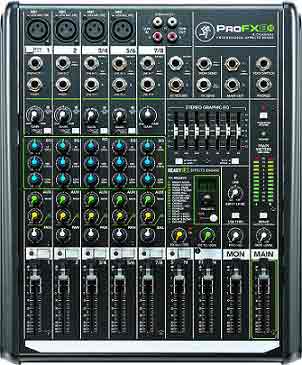
Best For Home Use
Key Features:
- Vita Mic Preamps
- ReadyFX Effects Engine
- No-Compromise Live Mixing Toolkit
- USB Recording / Playback
Mackie wants to be your new best friend because when it comes to audio, they’re the kind of friends you could always rely on! Meet the Mackie ProFX8v2 8-channel mixer, a sound system that offers an impressive feature set at an affordable price.
Also, it has small performing acts and smaller venues at home. Also, these mixers are packing with power for day-in and day-out road work. The best analog mixers for studios’ footprint keep things tidy while also offering all the right tools to get the job done well without jacking up your budget.
These mixers promise rock-solid performance with features like dual unbalanced ¼” combo inputs for connecting dynamics. Also, condenser mics; 3 dedicated phantom-powered mic/line ins; 3 AU.
Feature:
The Mackie ProFXv2, 8 A-B Box, 8-channel (PROFX8V2) is an eight-channel mixing console for recording studio use. The unit features four low noise Mackie Vita microphone preamps with phantom power.
Also, ensure high-quality sounds by reducing the common problem of noise and distortion during the amplification process.
This mixing board also contains a sound effects engine with 16 different effects, including reverbs, delays, and choruses to enhance your sound.
Also, it comes With seven-band graphic EQ on every input/output jack in addition to a 3-band EQ and 100 Hz low cut filter. Also, this product will be sure to make any podcast or commercial stronger! All features considering, we can say this is the best cheap mixer for home studio.
Pros:
- Perfect for recording guitars and vocals.
- Can use professional microphones like the Shure SM57.
- Perfect design.
- Best performance possible in your space.
Cons:
- It was also expensive.
7. Allen & Heath Zed-12fx 12-Channel Mixer:
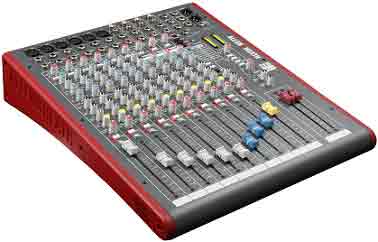
Best for Professional Use
Key Features:
- DuoPre XLR Microphone preamps
- A 100Hz High Pass Filter
- A routable stereo-in stereo
- Optional rack ear kit
- 6 Mic, 6 Line/ Inst, 3 Stereo
- A built-in, studio-quality multi FX unit
The Zed-12fx is the perfect solution for your live sound needs. It’s easy to use, portable and has all the features you need. You can mix 12 channels at once with 12 input channels, each with three-band EQ and panning controls.
However, it’s got four aux sends on every channel so you can send signals to external effects units or monitors from any point in the signal chain – even before they hit the faders!
Combining a fantastic feature set, rock-solid performance, and top quality sound design with a dramatically reduced size. The Zed-12FX is ideal for musicians of all stripes. This best 12 channel analog mixer offers unprecedented flexibility and power from beginners. Also, it is getting started with seasoned professionals at work on stage or in the studio.
The best 12 channel mixer is configure as four auxiliaries, six mic/line inputs, and three EQs controlling 18 positions like MID. Both mono inputs are linked together as one (for example, synths).
There are also 100mm Professional faders that feel right under your fingertips when tweaking EQ curves. Plus USB I/O for easy integration into any DAW and Allen & Heath’s ZED Software, including their exclusive Tone Match.
Pros:
- The Zed-12fx is the perfect solution for live sound, installation, and recording.
- It features 12 input channels with 3 band EQ.
- Metal chassis and high-quality components.
- Easy to use in any situation.
Cons:
- The faders are not smooth.
8. Zoom LiveTrak L-12 Digital Mixer & Multitrack Recorder:
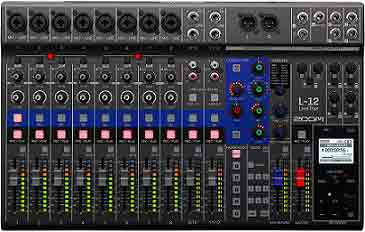
Best For Analog Mixer
Key Features:
- 12 discrete channels
- Frequency characteristics 44.1 kHz
- 5 powered headphone outputs
- 14 -in/4-out USB audio interface connectivity
- Scene saving function
- Effortless Live Mixer
- Record Everything, Remix Anywhere
- Five Custom Monitor Mixes
- USB Connectivity for Your DAW
- Advanced Onboard Effects
The Zoom Live Trak L-12 is the perfect solution for live sound and studio recording. It’s designed to be an all-in-one, professional mixing system that can handle anything from small clubs to large theaters.
With 12 channels of Input and output, it has everything you need in one compact package. You can even record up to 48kHz on your computer or SD card simultaneously!
The LiveTrak L-12 also features eight combo jacks that adjust XLR and both 1/4″ connectors. So you don’t have to worry about running out of inputs during a performance or session.
And with eight mic preamps with great sound with Phantom Power and +60 dB gain. Also, the quality will always be top-notch no matter what type of Microphone is being used.
The best 12 channel analog mixer channels with 8 XLR inputs can be used as mic or line level. You also have two stereo RCA inputs for keyboards and other audio devices. The built-in effects are significant too!
There’s a 3-band EQ on every channel to help you get your desired tone, plus 16 different types of effects to choose from. The best audio mixer for beginners comes with a compressor on every channel. So you don’t have any unwanted noise in your recordings.
This product is truly unique! Also, it has its built-in slate mic for recording comments or talking back, onboard metronome for keeping. Also, the band is in sync and has a tone of voice that’s informative but not too technical. So this device will make your life easier as a musician. It also has an onboard USB interface so you can connect it to any computer with no additional hardware needed!
Pros:
- It comes with amazing features.
- Easy to record.
- Connect any computer.
Cons:
- It doesn’t have the features you need to make the live sound for your band.
9. Behringer Xenyx X1622USB Premium 16-Input:
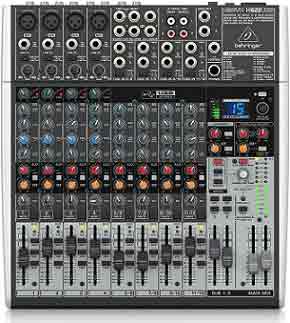
Best for Professional Use
Key Features:
- Sonically Superior Mic Preamps
- One-Knob Compression
- Sublimely Musical British EQ
- Klark Teknik
- New studio-grade FX processor
- 4 studio-grade compressors
The Behringer Xenyx X1622USB Premium 16-Input mixer is the perfect solution for anyone who wants to take their live or studio mixers to a whole new level. This premium ultra-low noise and high headroom analog mixer feature are Comparable to 4 state-of-the-art, Phantom-powered XENYX Mike.
Primps single boutique Primps and four studio-grade compressors with super-easy. “One-knob” functionality and control LED for professional vocal and instrumental sound. Its neo-classic British three-band EQs with the semi-parametric mid band for warm and musical sound. Also, this mixer has everything you need to produce your best work yet!
The best audio mixer with effects also equips a new studio-grade FX processor with 16 editable presets, including reverb, chorus, flanger, delay pitch shifter, and multi-effects.
You can even store user parameter settings on it! If you’re looking for an amazing-sounding mixing board at an affordable price, then look no further than the Behringer Xenyx X1622USB Premium 16 Input Mixer.
However, This mixer has 16 inputs, which means you can mix up to 16 different sources at once. It also comes with 2 mic preamps and 4 stereo channels. Also, it allows you to record from CD players, turntables, or any other audio device.
Pros:
- Low Price and user-friendly.
- High quality at an affordable price.
- Easy to use.
- Very durable.
Cons:
- Not perfect for an older computer.
10. Mackie 1604vlz4 16-Channel Compact 4-Bus Mixer:
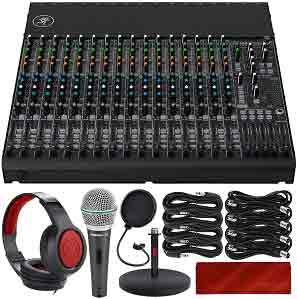
Best for Digital Mixer
Key Features:
- High-visibility, high-contrast controls
- Built-like-a-tank rugged steel chassis with powder
- Improved RF rejection
- Four stereo returns
- Bundled with Studio Monitor Headphones
The Mackie 1604vlz4 compact 4-bus mixer with 16 channels and eight aux sends. It has an ultra-low noise, high headroom design that delivers clean audio for any application.
You can use it as a main mixer or a sub mixer in the studio. Plus, it’s got all of the features you need to get started mixing, including EQs on every channel, inserts on every bus, and more!
This best digital mixer for recording studio will provide you with all the features. Also, you need to produce professional-quality sound from your live performances or studio recordings.
You’ll be able to mix up to four channels at once with ease, thanks to its intuitive layout and controls. Plus, it’s built like a tank, so you can take it on the go without worrying about damaging it!
This best recording console for a home studio is perfect for any live sound. Also, recording console applications where space is at a premium, but the quality isn’t compromised. Whether on stage or in your studio, this little powerhouse will get the job done with ease and style.
Achieve pristine clarity thanks to Mackie’s proprietary. Also, XDR2 preamps provide an extended dynamic range with virtually no distortion even when pushed hard into clipping. So you can top audio mixers confidently. Also, know that your audience will consistently hear every detail of your performance loud and clear!
If you’re looking for the best digital studio mixer yet professional-sounding mixer, then look no further than the Mackie 1604VLZ4. It’s perfect for any situation, whether recording or live sound mixing. You won’t find another mixer that offers such versatility at this price point anywhere else on the market today!
Pros:
- With its compact size and lightweight design.
- Easy to transport anywhere.
- You can easily set it up in any house room or take it on the road with ease!
- It is perfect for live sound recording.
Cons:
- Not enough features.
Also Read: How to Use a Mixing Console?
After buying a mixing console your second step is, to set it up properly. You can know here how to setup mixing console for recording. So read to know the details
How does a Mixing console work?
A mixing console takes many audio sources through its multiple stereo channels inputs. Also, it adjusts volume, equalizer, compression, and different sound attribute and finally combines to a mono output.
Simply taking the audio from performers, tweaking, and adding effects finally combine to a mono output. This combination is amplified through a PA (Public Address) system. Check For Details…
Parts of Mixing console:
A Mixing console has these parts-
Channel:
The main unit of a mixing console is the channel. The channel of this mixing console consists of several parts. If you have an idea about the mixing console channel, you can manage the mixing console. The different parts of the channel are described below.
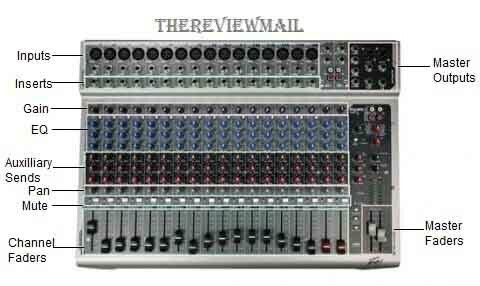
Input:
The input part is connecting to the audio source. It is connected to different sources, such as a keyboard or piano to a microphone. But it will have both a “jack input” for the line signal and an XLR connection for the Microphone.
Inserts:
Insert is a connection that plugs in to connect to different devices. All input and output devices are connected through this insert. It works perfectly so that other processes are not damaged. Its most common use is to insert a compressor or gate.
Gain:
Each controls the input level of different channels. Here you can set it so that the individual sound sources do not overload the channel and distort it.
EQ:
EQ enables the user to change the frequency curve of a word. For example, if a sound source is bright, high frequencies turn down, low frequencies convert to high frequencies and any frequency converter to mid-frequency.
Auxiliary sends:
Auxiliary sends adjust the transmitted channel’s signal level to the output.
Pan:
The acronym for Panorama is Pen. It controls where the sound will be heard in the stereo field. Also, this allows control of the sound transmitted to different outputs. You can send the signal as you need by turning it to the right or the left.
Mute:
This allows you to mute different channels individually. You can easily mute the output you don’t need.
Channel Fader:
It helps to control the level of noise transmitted to different outputs. These are the main tools for controlling the ‘mix’ of listening to a PA or recording console device.
Master faders:
These Master Faders control whether the signal level is transmitted to the main outputs. In the case of live setup, it is usually transmitted to the overall level PA system.
Master output:
This is where the work of all parts of the mixing console ends. Here comes the work of the mixing console.
Also Read: Cheap Bass Guitars
Buying Guide: Best Mixing Console For Recording Studio
The analog and digital mixers are the most important part of your PA system or recording studio that can be called the heart in a word. Also, it provides audio inputs and outputs, routing capabilities, and much more.
So when you want to buy a mixing console for your recording studio, there are some things you need to check seriously. Such as:
Channels:
In a word, you have to consider how many channels there are in the mixer. Because the more channels an analog and digital mixer has, the more stuff you can draw on it.
A mixing console has many channels such as Input, Inserts, Gain, EQ, Auxiliary sends, Pan, Mute, Channel Fader, Master faders, Master output, and many more. Also, these are the things you need to consider because you know very well why you are buying a mixing console.
So, I think you should take the combination to meet your needs with the console. I have just highlighted all the aspects of some good-quality combination professional consoles. According to your cheap sound mixers, you can easily choose which one will suit you better.
Buses:
The primary purpose of each channel in the mixer is to pass the signal on a bus. The mixer’s main output connects to the master mix bus, which the channel feeders feed.
In the mixer audio Channel Fader, Master faders, you have to consider whether you will get the process you want to control the system because this is a critical issue in a mixer.
Groups:
Featuring some large-sized mixing channel grouping features known as VCA groups, which is an advantageous way to manage many channels. Each group matrix is like its own mix between your channel and the main bus.
The process of work. In groups, it is quite simple. So, you have to consider this aspect as well. You assign an output to each channel you want to control in a group feeding the father. For example, you can send all your drums to group 1 and all your voices to group 2.
Each group has its output feeder, which then feeds the master boss. This allows you to completely control entire segments of your mix with just a few feeders without affecting each group’s relative mix of channels.
Mute Groups and Scenes:
In addition to the mixing groups, each mixer also has a silent group. These allow you to individually control and set individual channels so that you can use multiple channels at once to mute or noise.
If you want to mute the whole band while just talking to a single song or presenter, you can do it. So, you must consider this issue so that the mixing console you want to take can meet your needs.
Inserts and Direct Outputs:
You need to consider Inserts and Direct Outputs when buying a mixing console. You need to see how many Inserts and Direct Outputs it has because you know how many or how many Inserts and Direct Outputs lines you need.
That’s why when buying any mixing console, you need to consider whether what you are going to buy can meet your needs. So if you do not accept your conditions in mind, you will find yourself in an awkward situation. So, one must consider the feudal aspect of a mixer and its disadvantages.
It’s just that no product can be 100% suitable for everyone. So, I have tried to analyze some of the best combination consoles in the current market.
If you want to know which mixing console is the best analog or digital mixing console. So this blog analog vs digital mixing console.
FAQ of Best Mixing Console for Recording Studio
01. What Is The Best Quality, Audio Mixer?
If you’re in the market for an audio mixer, it can be challenging to know which one is best. There are so many different options available, and they all have their pros and cons. But don’t worry!
We researched for you and found some of the best quality mixers on the market today. These mixers offer excellent sound quality, durability, versatility, ease of use, and more. You won’t regret buying any of these!
With a wide range of features that will suit your needs no matter what type of music or recording studio environment you’re working with – from home studios to professional studios – there’s something here for everyone!
Whether you’re just starting or looking to upgrade your current setup, we’ve got everything covered. So take a look at our list below and find your perfect match today!
- G-Mark professional Audio Mixer with 16 Channel
- Mackie Profx8v2 8-Channel Compact Mixer
- Allen & Heath Zed-12fx 12-Channel Mixer
- Yamaha Emx5014c 14-Input Powered Mixer
- Yamaha Ag03 3-Channel Mixer / 1 Microphone
- Peavey Pvi 6500 400-Watt 5-Channel Powered Mixer
- Zoom Livetrak L-12
- Mackie 1604vlz4 16-Channel Compact 4-Bus Mixer
- BehringerXenyx X1622USB Premium 16-Input
- Mackie Profx12v2 12-Channel Compact Mixer
02. What Are Mixers Used For In Studios?
Mixers are a crucial part of any recording studio. They allow you to combine and balance the levels of multiple audio sources, such as microphones, instruments, or vocals.
Also, this is adjusting the volume level on each input channel and then balancing them with one another using the faders on the mixer’s control panel.
The result is a well-balanced sound that can be recorded onto an analog or digital media like tape or hard drive, respectively. A mixer’s output is typically connected to a power amplifier and loudspeakers for live music events or playback through headphones for recording purposes. Read More…
03. What Equipment Is Needed For a Professional Recording Studio?
You might be wondering what kind of equipment is needed for a professional recording studio. Many different types of gear can help your business succeed and grow.
There’s no one-size-fits-all solution here, so we recommend starting with the basics first. Like microphones, speakers, mixers, amplifiers, cables, and more!
Microphone:
The most important piece of equipment in any recording studio is the Microphone. It captures sound from instruments or vocals and converts it into an electrical signal recording on tape, digital media, etc.
Microphones come in all shapes and sizes, but they all have two things in common – they convert sound waves into electrical signals, which can then be processed by other devices such as amplifiers or mixers.
Also, they require power to operate (either through batteries or phantom power). So if you want to record anything at all, make sure you have a good mic!
If you want to read an excellent review of some of the best microphones, check our other article about the best condenser mic under 200.
Speakers:
A professional recording studio needs speakers. The quality of the sound coming from your speakers will impact the quality of your recordings. If you are looking to create high-quality recordings, you must invest in good speakers.
Mixers:
If so, then you will need a professional mixer. A mixer is the heart of any sound system, and it’s what allows all the different inputs to be combined in an organized way.
Without one, there would be no way to combine sounds from microphones or instruments into a single that can go out through speakers or headphones. Already we discuss in this article how mixers work and which ones are best for your needs.
Amplifiers:
If you are looking for the best equipment for a professional recording studio, you should know that amplifiers are one of the most important pieces.
Amplifiers provide power to your speakers and control how loud or soft your music sounds. Also, it is both live performances and recordings. There are many different types of amps available on the market today. So, it is important to find one that will work with your needs.
Also Read : How to Connect Amplifier to Mixing Console?
Cables:
A professional recording studio needs cables to connect all the different pieces of equipment. Without them, you can’t record any sound! Many types of cables are used in a studio, but they’re not all created equal.
Some are better than others, and some have more features than others. So which one should you use? That’s what we’ll find out today!
04. How Do I Make My Mixer Sound Better?
The solution is simple! All you need is a small USB device called an audio interface connecting your computer. Also, the mixer input jacks on one side and an XLR cable (or two) connecting from the mixer’s output jacks to your microphones on the other side.
This will clean up those nasty noise problems by boosting low signals to line level so they won’t get lost in digital conversion anymore! It’ll also give you a gain control knob per channel so you can adjust each mic volume individually instead of having one single master volume knob.
05. Do I Need a Mixer For Recording Studio?
So no, you do not want a mixer to report track at home. You nonetheless want an audio interface/preamp, Microphone, and DAW. However, those gadgets might not run you that well compared to a hefty blending board.
Mixers are available on hand for making extra nuanced blending choices as soon as you understand what you are doing.
06. Are Mixers Good For Recording?
If you’ve got a mixer console that applies top exceptional reverb, EQ, and compression, then yes. However, a number of these will additionally end in top recording software. So, long as you’ve got a good interface to file your signal.
Also Read: How to Setup Mixing Console for Recording?
07. How to Fix Dead Channels on a Mixer?
To fix a dead channel on your mixer, you will need to first identify the channel that is not being received. Next, use a test tone to check if the channel is receiving the audio signal. If it is not, then you will need to find the source of the noise and fix it.
This may require using a filter or a cable splitter. Once the noise is fixed, you will need to test the channel again to make sure that the audio is now working properly.
If you are still experiencing issues with your mixer, then it is best to seek professional help.
Conclusion
Finally, the best mixing console for recording studio can give an outstanding recording performance make crystal clear sound. Also, it is the live performance and then shares output through an external device.
Every company discovers a new product by the inclusion of an Attractive feature. In the above, I try to give you some best console mixer information, and the same way apply to home studio mixers. Professionals most widely use them to beginners for their features and decent Price. Just choose your desired one considering your requirement and expended cost for this item.
Hopefully, we think that you must understand our best mixing console for recording studio guidelines, and now you will be able to choose the right product for you.
Related Post:
How to Use a Digital Mixing Console?
How to Use a Analog Mixing Console?
Mixing Console Troubleshooting Checklist!
Best Mixing Desk for a Recording Studio
best affordable condenser mic for vocals
MXL 770 Review : Best Cardioid Condenser Mic
Top 8 Best Electric Guitar Under 300
Top 6 Best Budget Audio Mixer Review
What is Matrix on Mixing Console?
How to Build a Mixing Console?
How to Build a Mixing Console Desk?
Analog Vs Digital Live Sound Mixing Consoles

Williams Kane is a blogger and writer. He’s passionate about writing and connecting with the community, especially when it comes to sharing his ideas through writing.
I am a versatile author with a passion for exploring a wide range of topics on our multi-niche website. With a background in research and a love for writing, I bring a unique blend of expertise to our platform.
My journey began in the world of science, where I earned a degree in biology and developed a deep fascination for the natural world. This background enables me to delve into topics related to ecology, environmental conservation, and the wonders of the animal kingdom.
However, my curiosity knows no bounds, and I have ventured into various other niches as well. From technology trends and digital innovations to health and wellness tips, I strive to provide well-researched and engaging content that informs and entertains our diverse audience.
Furthermore, my dedication to staying current with the latest developments in each niche ensures that our readers receive up-to-date and reliable information. Whether it’s deciphering complex scientific concepts or simplifying tech jargon, I take pride in making complex subjects accessible to all.
Join me on our multi-niche journey, where we explore the depths of knowledge and share insights on a multitude of topics to inspire, educate, and entertain.




